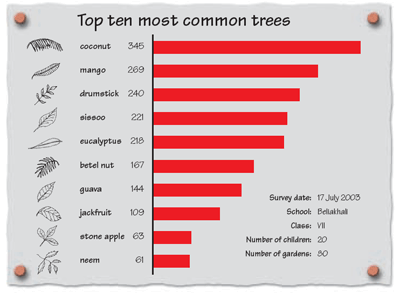This activity can be used with children to help them learn about their surroundings. They will also learn about the use of surveys, ranking and charts to collect and display information. Farmer groups could find these techniques useful in surveying local trees or when selecting popular species to grow in tree nurseries. The activities could be adapted to study crops, foods, livestock or type of work.

Articles
Tree surveys
Farmer groups could find these techniques useful in surveying local trees or when selecting popular species to grow in tree nurseries. The activities could be adapted to study crops, foods, livestock or type of work
2003 Available in Portuguese, Spanish, French and English

From: Learning from disaster – Footsteps 56
Advice on how communities can prepare for the unexpected

Raising questions
Discuss the different trees that we find in our surroundings. Help children to think about why they like certain trees and encourage them to think about the different characteristics for their choices – such as height, fruit, good for climbing, firewood. Make a list of the trees that have been mentioned and let the children vote by show of hands to rank them in order of popularity. Help them make a chart of their top ten trees.
Data collection
Ask the children to observe the different trees around their homes or gardens and make a list of these trees in their note-books. Then count up the numbers of each tree. If they don’t know the name of a tree, they should collect some leaves and write out a description of the tree, its fruits and flowers for identification later.
Summary of data
Divide the children into small groups. Ask each group to give a summary of the information they have collected. The children can exchange information and ask each other the names of unknown trees. If there are trees that are hard to identify, consider asking older people with a good knowledge of their environment for help. Then summarise the information of the whole class.
Help the children to produce a chart with a simple bar graph showing the ten most common trees. Make the chart interesting by either drawing the leaf of each tree or by making leaf impressions using paint.
Remember to include some basic information such as the date of the survey, name of the community, number of children who took part and their class and school. After making this chart, discuss with the children why they think those ten trees are most common. Discuss the differences between the two charts. Suggest making another chart describing the uses of the different trees.
Benefits
This exercise should stimulate interest in looking at trees and appreciating their benefits. Identifying trees that are popular with children but not commonly grown could provide a reason to build a tree nursery near the school, where children could learn the skills of raising seedling trees. This exercise could be repeated looking at roadside trees, trees that grow near a pond or river or near agricultural fields.
Trees can play an important role in protecting the environment from the dangers of soil erosion and flooding and in preventing mud slides. Observing and valuing trees is important for all of us.

Similarly Tagged Content
Share this resource
If you found this resource useful, please share it with others so they can benefit too.

Subscribe to Footsteps magazine
A free digital and print magazine for community development workers. Covering a diverse range of topics, it is published three times a year.
Sign up now - Subscribe to Footsteps magazine





